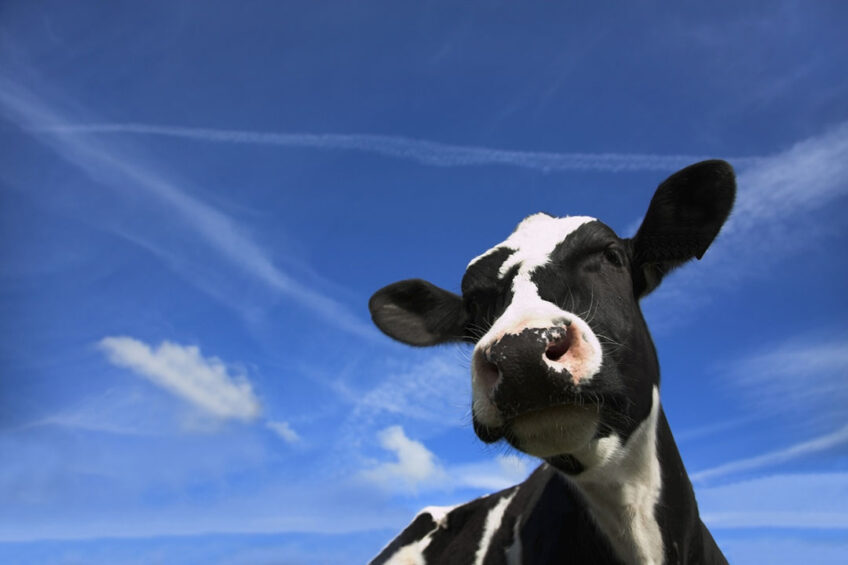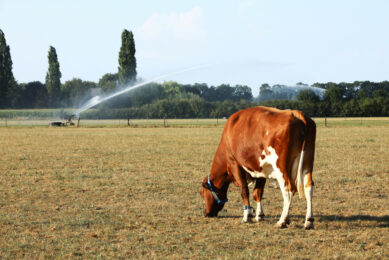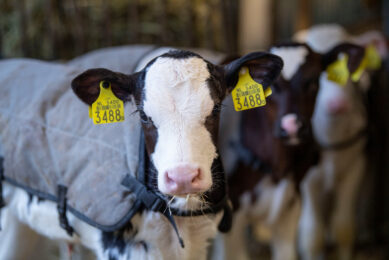Heat stress affects every stage of the cow cycle

Emerging evidence indicates that heat stress profoundly affects calves and cows from the prenatal stage through lactation.
As global temperatures rise, so does heat stress in dairy production. Heat stress occurs when a cow’s ability to disperse heat produced through normal metabolism is compromised, which usually happens when the ambient temperature exceeds the thermoneutral zone (TNZ). The TNZ is defined as the temperature range in which an animal maintains normal body temperature without altering metabolic heat production or employing evaporative heat loss mechanisms.

Heat stress becomes more severe as ambient temperature and humidity increase, which means the temperature-humidity index (THI) is one of the effective indicators of heat stress. When the THI is higher than 72, heat stress is observed in dairy cattle. However, the threshold for heat tolerance depends on breed and milk production level — higher production levels are more sensitive to high temperature and humidity. On the other hand, heat load can also increase with direct sun exposure, implying that a lack of shading with a high THI can exacerbate heat stress. Studies around the globe are showing the effects of heat stress on the animal’s immune status and milk production, which highlights the need for a holistic approach to combat the effects of heat stress. This is what researchers at the University of Florida focused on as they analysed how heat stress affects every stage of the cow cycle.
Pre-weaned calves
Like mature cows, when calves exceed their ability to dissipate heat and maintain homeostasis, physiological heat stress occurs. However, the thermal neutral zone for calves is narrower. Calves under 3 weeks of age have a thermal neutral zone between 15–25.6°C, whereas for calves older than 3 weeks this lies between 20–21°C. Above these temperatures, the calf will shift energy from growth to maintaining body temperature. Physiological and behavioural impairments (i.e. reduced feed intakes, increased maintenance energy needs, and lowered immunity) can lead to poor growth, higher susceptibility to disease, and in extreme cases, death. There is a link between calf heat stress and subsequent performance, where higher temperatures and humidity experienced by calves result in higher heifer age at first calving.
 5 things the dairy farmer can do to combat heat stress
5 things the dairy farmer can do to combat heat stress
Now in the summer months, temperatures can tip the scales at well over 30°C in parts of Europe.
Growing heifers
2 notions affect efforts towards heat stress management in heifers:
1. Heifers are less impacted by heat stress than lactating cows are, and
2. The economic return yielded by managing heat stress in growing heifers is not immediately evident.
This does not mean, however, that heifers are not affected by heat stress. Studies show that when exposed to elevated ambient temperature from 10°C to 35°C, yearling heifers exhibit increased rectal temperature, respiration rate, and pulmonary ventilation rate (volume of exhaled air per minute). Those symptoms are similar to a mature heat-stressed cow and suggest that heifers also suffer from hyperthermia. Some studies also reveal that heat stress increases immune responses in heifers.
Lactating cows
There is evidence that heat stress exacerbates the occurrence of both mastitis and metritis in lactating cows – as temperature and humidity rise, there are effects on host response to pathogens that are associated with elevated incidence of disease. Several studies agree that heat stress increases immune responses when compared to cooler ambient temperatures. Studies conducted in temperate and subtropical environments show that elevations in THI during summer months is associated with higher somatic cell counts (SCC) at the herd level. A concomitant decrease in milk volume and quality is also observed.
In another study with limited heat stress abatement in early lactation, cows exposed to a cooling showed improvements in immune status. Similarly, in an arid environment with mean daily temperatures of 37°C, exposure to fans and misters from 10am to 6pm each day improved milk yield and dry matter intake compared to cows that received no heat abatement. In the same study, heat stress increased SCC in milk, but depressed circulating immunoglobulin (IgG) and inflammatory cytokines, supporting the idea that cow immune function is adversely affected by heat stress during lactation. Some studies have shown that milk yield declines when body temperature exceeds 38.9°C, and, for each 0.55°C rectal temperature increases, milk yield and intake of TDN declines by 1.8 and 1.4 kilogrammes respectively. As a result of heat stress, more energy is directed towards cooling down and less energy is directed towards milk production.
 3 key factors for optimal herd health and performance
3 key factors for optimal herd health and performance
Numerous factors can impact dairy herd health and performance, including genetics, management, housing and stress.
Dry cows
This stage in the cycle of the dairy cow is important since studies show that intra-mammary infections peak around the dry-off period and calving relative to all other phases of lactation. The incidence rates vary in line with the season but are typically elevated in the summer season as compared to the winter season. Heat stressed dry cows have depressed lymphocyte proliferation relative to cooled cows. Heat stress depresses responses to antigens, which may have implications for vaccination protocols used during the dry period to prepare cows for the next lactation. A ‘carry-over’ immune status effect is also observed in lactating cows, as studies show that oxidative burst activity (cell phagocytotic activity) is enhanced in cows that are cooled when dry relative to those that were under heat stress, even though all cows are cooled during lactation.
Management interventions
The following three approaches to alleviating the impact of heat stress are usually explored:
1. Modification of the environment,
2. Genetic selection for heat tolerant cows, and
3. Nutritional management.
Because genetically altering the thermal tolerance of high producing animals is usually not easy, and because there are many reviews covering nutritional and metabolic responses and nutritional management for heat-stressed dairy cattle, this section will briefly review heat abatement by physical modification of the environment.
Implementing cooling strategies
Providing shade effectively blocks solar radiation and is advised as the first step in heat abatement. Intensive cooling using fans, water or air conditioning minimises the loss of milk yield and is associated with significant economic return for dairy producers. Researchers found that in the subtropical climate of Florida, cooling with access to shade alone dramatically decreases body temperature and respiration rate of lactating dairy cows and improves milk yield by 11–20%. A mature dairy cow requires 3.5 to 4.5m2 shade space, and the shade should be 3.5–4.5m high to minimise the radiation from shade roof to cows. Soakers or sprinklers have the advantage of delivering large water droplets through a low-pressure water line to wet the skin and coat the cows’ hair.
 Promising efforts to lower enteric methane
Promising efforts to lower enteric methane
Researchers around the world are searching for new ways to lower emissions.
Studies show that evaporative cooling using sprinklers and fans, or misters, in the holding area before milking effectively reduces cow body temperature after milking, and results in 4–5% increase in milk yield of lactating dairy cows in grazing-based dairies. Similarly, the airflow provided by fans facilitates the evaporation of water from the skin, which carries heat directly away from the cow’s body. Another intervention is a mist cooling system and fans over the feedline and stalls. In naturally ventilated barns, additional fans increase ventilation and air velocity, which enhances heat loss by convection.
While the strategies for heifers and cows are similar, studies show that the use of automatic feeders coupled with the increased popularity of group-housing creates an opportunity for the implementation of active cooling strategies to provide heat abatement more efficiently to calves. For example, increasing the shade area (i.e. solid roof) and airflow and the option to add ventilation systems, such as natural ventilation (i.e. curtains and open walls), fans, or positive-pressure tubing are all possible with group housing more so than it is with individual housing (stalls).
Join 13,000+ subscribers
Subscribe to our newsletter to stay updated about all the need-to-know content in the dairy sector, two times a week.










